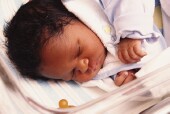
THURSDAY, Dec. 4, 2014 (HealthDay News) — A new analysis of the whooping cough epidemic in California finds that infants have been hit the hardest, and it calls for increased efforts to vaccinate pregnant women so their babies are protected.
In what state health officials are calling the worst outbreak in 70 years, 9,935 cases of whooping cough (pertussis) were diagnosed between Jan. 1 and Nov. 26. That translated into 26 cases per 100,000 people, according to a report in the Dec. 5 issue of the U.S. Centers for Disease Control and Prevention’s Morbidity and Mortality Weekly Report.
“Pertussis incidence is likely to continue to increase in the United States due to the natural cycle of disease and the waning of immunity conferred by currently available vaccines,” according to the CDC report. “Strategies to prevent the most severe cases of pertussis, which occur primarily in young infants, should be prioritized.”
Whooping cough is highly contagious, and is typically spread through coughing and sneezing. The Tdap vaccine protects against this respiratory illness.
While infants under the age of 1 year were the most susceptible to both the disease and its serious complications because they were too young to be vaccinated, Hispanic infants were 70 percent more likely to catch whooping cough, the report found. Overall, the disease rate among infants under the age of 1 year was 175 per 100,000 people.
The researchers weren’t able to explain why Hispanic infants were more vulnerable, although they suggested that larger family households and cultural differences might play a role.
Infants were also much more likely to wind up in the hospital after catching whooping cough. Of the 347 hospitalizations that were reported across the state, 275 were under the age of 1 year, including 214 under the age of 4 months, according to study author Kathleen Winter, of the California Department of Public Health, and colleagues.
When the researchers looked more closely at the available data, they found that most of the mothers of the infants who caught whooping cough had not been vaccinated.
“Very few mothers of infants with pertussis had received Tdap during pregnancy; many more were vaccinated after delivery, which does not confer any direct protection to the infant and is no longer a preferred strategy,” the researchers wrote. “Recently published data indicate that Tdap vaccination coverage among pregnant women [in California] was only 19.5 percent in 2012.”
Recent research has shown that vaccinating women in the third trimester of pregnancy confers protection to the fetus, and health care providers need to encourage pregnant women to get the vaccine, the report authors added.
There was also a spike in the number of teens who caught milder cases of whooping cough, even though 87 percent of them had been vaccinated against the disease as children. That suggests that their immunity was waning and that this population might need booster shots with the newer, more effective version of the vaccine, the report authors said.
More information
Visit the U.S. Centers for Disease Control and Prevention for more on whooping cough.
Copyright © 2025 HealthDay. All rights reserved.

